
Star Raiders is a space combat simulator video game created by Doug Neubauer and published in 1980 by Atari, Inc. Originally released for the Atari 400/800 computers, Star Raiders was later ported to the Atari 2600, Atari 5200, and Atari ST. The player assumes the role of a starship fighter pilot, who must protect starbases from invading forces called Zylons. Piloting and combat are shown in the 3D cockpit view, while a 2D galactic map shows the state of the Zylon invasion. Neubauer made the game in his spare time at Atari, inspired by contemporary media such as Battlestar Galactica and Star Wars, as well as the 1971 mainframe game Star Trek.
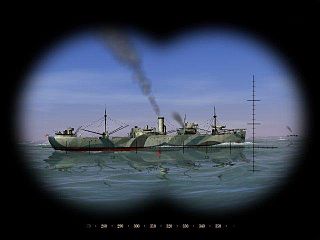
A submarine simulator is a video game in which the player commands a submarine. The usual form of the game is to go on a series of missions, each of which features a number of encounters where the goal is to sink surface ships and to survive counterattacks by destroyers. Submarine simulators are notable for the highly-variable pace of the game; it may take hours of simulated time to get into position to attack a well-defended convoy, and sub simulators typically include an option for players to adjust the ratio of real time to simulated time up and down as desired.
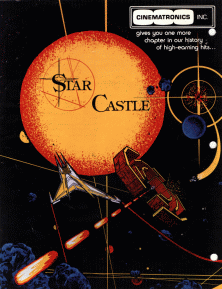
Star Castle is a vector graphics multidirectional shooter released in arcades by Cinematronics in 1980. The game involves obliterating a series of defenses orbiting a stationary turret in the center of the screen. The display is black and white with the colors of the rings and screen provided by a transparent plastic screen overlay.

Air-Sea Battle is a fixed shooter developed and published by Atari, Inc. for the Atari VCS. Air-Sea Battle is partially based on the 1975 Atari arcade video game Anti-Aircraft where each player uses a ground-based gun to shoot passing aircraft. The cartridge adds other variants, such as planes dropping bombs on ships and a carnival-themed shooting gallery.

Star Raiders II is a space combat simulator released in 1986 for Atari 8-bit computers as a sequel to 1979's Star Raiders, which was the killer app for the system. The game was originally developed as part of a tie-in with the movie The Last Starfighter, which featured an arcade game of the same name as part of its plotline. Versions for the Atari 5200 and the Atari 8-bit computers were developed in 1984, although those were never released. Later the tie-in was dropped, and the game converted into a sequel to Star Raiders by changing a number of gameplay elements. The gameplay remained different from the original Star Raiders.
Synapse Software Corporation was an American software developer and publisher founded in 1981 by Ihor Wolosenko and Ken Grant. Synapse published application software and developer tools and was primarily known for video games. It initially focused on the Atari 8-bit computers, then later developed for the Commodore 64 and other systems. Synapse was purchased by Broderbund in late 1984 and the Synapse label retired in 1985.

Arashi(嵐, "Storm") was a Kagerō-class destroyer of the Imperial Japanese Navy.

A destroyer tender or destroyer depot ship is a type of depot ship: an auxiliary ship designed to provide maintenance support to a flotilla of destroyers or other small warships. The use of this class has faded from its peak in the first half of the 20th century as the roles and weaponry of small combatants have evolved.
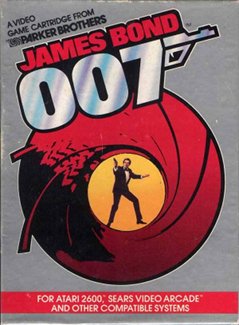
James Bond 007 is a horizontally scrolling shooter published in 1984 by Parker Brothers for the Atari 2600, Atari 5200, Atari 8-bit computers, Commodore 64, and ColecoVision. It was developed and published in Japan by Tsukuda Original for the SG-1000 under the title 007 James Bond. It was the first video game based on James Bond to be given a worldwide release.

Sea Wolf is an arcade video game designed by Dave Nutting and released by Midway in 1976. It is a video game update of an electro-mechanical Midway game, Sea Devil, itself based on Sega's 1966 electro-mechanical arcade submarine simulator Periscope. The game was released in Japan by Taito. In Sea Wolf, the player, piloting an unseen submarine, launches torpedoes vertically in an attempt to sink ships moving horizontally across the screen before time runs out. The screen is viewed through a faux periscope mounted on the cabinet.
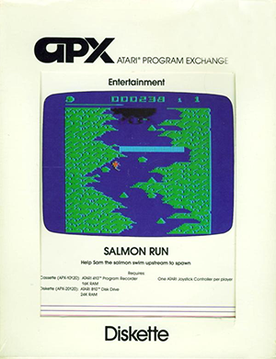
Salmon Run is a 1982 video game for Atari 8-bit computers created by Bill Williams and distributed via the Atari Program Exchange. Salmon Run was the first game in Williams's career, followed by a string of successes noted for their oddball concepts. The player takes the role of Sam the Salmon, swimming upriver to mate. Along the way he encounters waterfalls, a bear, fishermen, and seagulls.
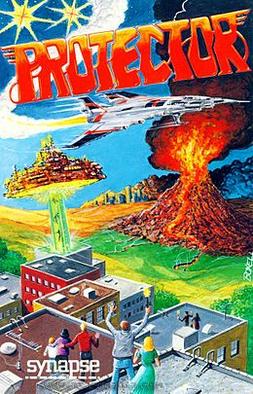
Protector is a 1981 scrolling shooter for Atari 8-bit computers programmed by Mike Potter and distributed first by Crystalware and then Synapse Software. A VIC-20 port was published by HesWare in 1983.

Attack at EP-CYG-4 is a shoot 'em up video game created by Mike Edwards for Atari 8-bit computers and published by his company BRAM, Inc. in 1982. It allows two players to cooperatively control the action against a computer enemy, in a fashion similar to Synapse Software's Survivor, also released in 1982. EP-CYG-4 was the first of Edwards' game efforts, and its success led to the creation of Zombies, which was published by Electronic Arts as Realm of Impossibility.

Shadow World is a shoot 'em up for Atari 8-bit computers written by Mike Potter and published by Synapse Software in 1983. Players are defending their planet from an alien invasion. The game supports two players at once, splitting the screen vertically into two halves, and merging them on the fly when both players are in the same location.

Slime is an action game for Atari 8-bit computers written by Steve Hales and published by Synapse Software in 1982. The player attempts to protect their ship from a rain of enormous drops of slime by deflecting them into canisters, while fending off attacks by an alien flying saucer. A TI-99/4A port was developed as Super Storm, but not released.

Submarine Commander is a simulation video game for Atari 8-bit computers written by Dean Lock and published by Thorn EMI Computer Software in 1982. A VIC-20 port by Gary York was released in 1983 and an Apple II version by Patrick Buckland the same year. The Atari version was re-released in 1985 on cassette on the Sparklers budget label. A version for the TI-99/4A was announced but was not released until 1986 when a third party bought the rights.
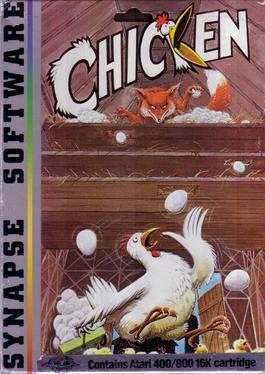
Chicken is a video game for Atari 8-bit computers written by Mike Potter and published by Synapse Software in 1982. The game is similar to Atari, Inc.'s. 1978 arcade video game Avalanche, replacing the buckets and boulders with a hen trying to catch her eggs.

Dimension X is a first-person vehicular combat game for Atari 8-bit computers released in 1984 by Synapse Software. It was designed by Steve Hales, who previously wrote Slime and Fort Apocalypse for Synapse. Dimension X has gameplay similar to Atari's Battlezone and Novagen's Encounter. The player controls an attack craft hovering over a checkerboard-patterned landscape while to destroy enemy ships.
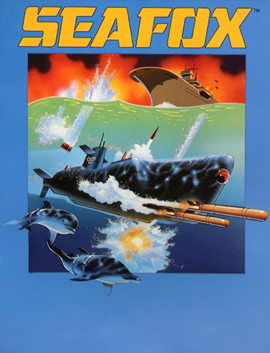
Seafox is a shoot 'em up written by Ed Hobbs and published by Broderbund in 1982 for the Apple II and as a cartridge for Atari 8-bit computers. A VIC-20 port, also on cartridge, was released in 1983.

Protector II is a video game written by Mike Potter for Atari 8-bit computers and published by Synapse Software in 1982. It is a sequel to 1981's Protector; both games are horizontally scrolling shooters inspired by the arcade video game Defender. Protector II was ported to the Commodore 64, TI-99/4A, and TRS-80 Color Computer.




















